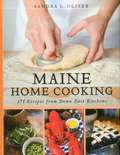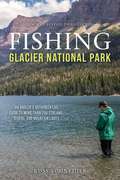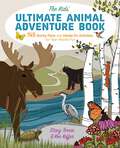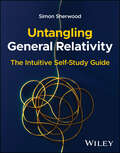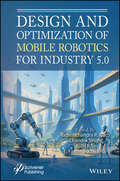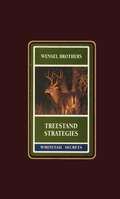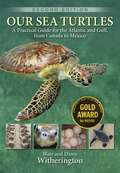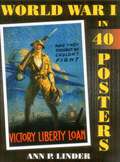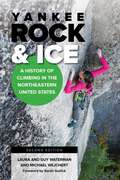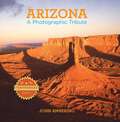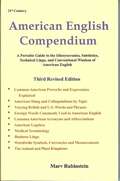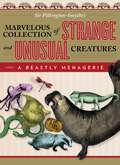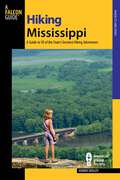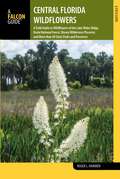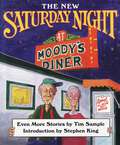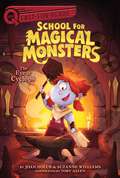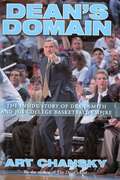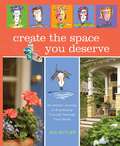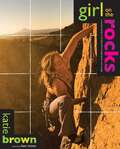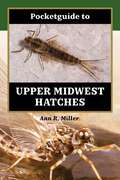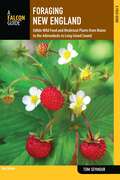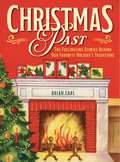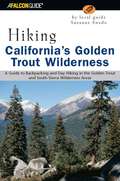- Table View
- List View
Maine Home Cooking: 175 Recipes from Down East Kitchens
by Sandra OliverResiding on Maine's Islesboro Island, Sandra Oliver is a revered food historian with a vast knowledge of New England food history, subsistence living, and Yankee cooking. For the past five years, she has published her weekly recipes column, "Tastebuds", in the Bangor Daily News. The column has featured hundreds of recipes—from classic tried-and-true dishes to innovative uses for traditional ingredients. Collecting more than 300 recipes from her column and elsewhere, and emphasizing fresh, local ingredients, as well as the common ingredients found in most kitchens, this volume represents a new standard in home cooking.
Fishing Glacier National Park: An Angler's Authoritative Guide to More than 250 Streams, Rivers, and Mountain Lakes
by Russ SchneiderFishing Glacier National Park includes over 250 fishing locations from Waterton Lake to the Flathead River. This guide uncovers streams and lakes for Kokanee salmon, mountain and lake whitefish, arctic grayling, and trout--lake, brook, rainbow, and cutthroat. Novice as well as expert anglers will find that the trails and roads in Glacier lead to more than spectacular vistas--many of them lead to great fishing sites.
The Kids' Ultimate Animal Adventure Book: 745 Quirky Facts and Hands-On Activities for Year-Round Fun
by Stacy Tornio Ken KefferThe Kids&’ Ultimate Animal Activity Book takes the best animal material from Stacy and Ken&’s previous titles and puts it in a single book that kids will love and come back to time and again. Organized in a see, learn, do (interact) format, the book first lays the groundwork for observing and learning about the animals—from their behavior and habitat to the truths and myths about them—and then jumps into lots of animal-related activities (like finding caterpillars or inspecting lizards).
Untangling General Relativity: The Intuitive Self-Study Guide
by Simon SherwoodAn easy-to-read introduction to Einstein’s theory of general relativity In Untangling General Relativity, Simon Sherwood explains the details of general relativity with clarity, enthusiasm, and a sense of fun. Designed to be accessible to non-experts, the book combines intuitive explanations with the essential mathematics needed for a deep understanding of the subject. Sherwood introduces that maths gradually and clearly, in a step-by-step program designed to expand your appreciation and grasp of general relativity. Untangling General Relativity serves as an effective springboard for more in-depth studies. It lays the groundwork for mastering the advanced topics covered in relativity textbooks and university physics courses. Readers will find: A thorough introduction to general relativity, including the interpretation of gravity as curved spacetime and a full derivation of Einstein’s field equationsComprehensive explanations of the spacetime metric, the equivalence principle, the geodesic equation, and the energy-momentum and curvature tensorsVacuum curvature: the Schwarzschild and Kerr metrics, black holes, white holes, event horizons, and gravitational wavesCosmology: the Friedmann equations, dark matter and energy, the Big Bang, inflation and an overview of current efforts to develop a quantum theory of gravity Perfect for undergraduate students preparing to take a university-level physics course dealing with general relativity for the first time, Untangling General Relativity will also benefit students of the natural sciences and instructors and educators with a professional or academic interest in the subject.
Design and Optimization of Mobile Robotics for Industry 5.0
by Rathishchandra R. Gatti Chandra Singh Ajith B. S. E. Fantin Irudaya RajHarness the future of automation with this comprehensive guide, offering an in-depth look at how next-generation mobile robotics are driving the transition to a human-centered and sustainable Industry 5.0. Design and Optimization of Mobile Robotics for Industry 5.0 delivers an in-depth, interdisciplinary look at how next-generation mobile robotic systems are enabling the evolution from Industry 4.0 to a more human-centered, resilient, and sustainable Industry 5.0. This book addresses the technical, ethical, and societal dimensions of robotics technologies, from design principles and autonomous navigation to human-robot interaction and AI integration. It brings together cutting-edge research and real-world case studies across smart manufacturing, agriculture, healthcare, and industrial automation. Readers will explore topics such as digital twins, IoT-enhanced robotics, sensor fusion, and collaborative robotics. With contributions from leading global experts, this volume serves as a comprehensive guide for those involved in designing, deploying, or studying robotics systems that align with the goals of Industry 5.0.
Knack Baby Sign Language: A Step-by-Step Guide to Communicating with Your Little One (Knack: Make It Easy)
by Suzie ChafinFew children can communicate effectively before eighteen months of age, but sign language can allow baby and parent to reduce the frustration up to a year earlier. With more than 450 full-color photos, text, and sidebars, Knack Baby Sign Language provides a user-friendly, efficient method to learn and teach a baby sign language. Organized by age, it provides signs appropriate to use with babies, with toddlers, and with older children for whom signing with games, songs, and rhymes is enriching. The signs can also be used with special needs children and those with delayed communication abilities.
Treestand Strategies
by Gene WenselIn this book the Wensel brothers take you through all the whys, wheres, and how of hunting from a treestand.
Our Sea Turtles: A Practical Guide for the Atlantic and Gulf, from Canada to Mexico
by Blair Witherington Dawn WitheringtonOur Sea Turtles is the story of understanding, experiencing, and saving the sea turtle and helping them thrive in our oceans. Now in its second edition, Blair and Dawn Witherington&’s iconic book includes updated facts and figures, new photos, and new calls to action for saving the turtles. Well-organized sections that are full of photos, maps, and figures help readers get a sense of the various types of sea turtles and how they might be similar or different from one another. Those who are interested in not only learning about the marine animal but also in helping it benefit from the authors&’ precise knowledge and understanding of sea turtles.
World War I in 40 Posters
by Ann P. LinderPublished during the war's centennial, this is the story of the First World War through forty propaganda posters. Essays explain each poster, unpacking the visual imagery and setting the poster within the military, political, social, and cultural history of the war.
Cowboys, Creatures, and Classics: The Story of Republic Pictures
by Chris Enss Howard KazanjianTake one well-oiled effective killing machine, add a familiar hero on the ground, in the air, and on horseback; stir in a ghastly end that&’s surely impossible to escape, add action, add passion, made on a shoestring budget at breakneck speed, and you&’ve got the recipe for Republic Pictures. Who, after all, cannot forget The Atomic Kid, starring Mickey Rooney, or The Untamed Heiress, with an un-Oscar-worthy performance by ingénue Judy Canova? Exploding onto the movie scene in 1935, Republic Pictures brought the pop culture of the 30s and 40s to neighborhood movie houses. Week after week kids sank into their matinee seats to soak up the Golden Age of the Republic series, to ride off into the classic American West. And they gave us visions of the future. Visions that inspire film makers today. Republic was a studio that dollar for dollar packed more movie onto the screen than the majors could believe. From sunrise on into the night over grueling six day weeks, no matter how much mayhem movie makers were called upon to produce, at Republic Pictures it was all in a day&’s work. Republic Pictures was the little studio in the San Fernando Valley where movies were made family style. A core of technicians, directors, and actors worked hard at their craft as Republic released a staggering total of more than a thousand films through the late 1950s. Republic Pictures was home to John Wayne for thirty-three films. Always inventing, Republic brought a song to the West. It featured the West&’s first singing cowboy. Republic brought action, adventure, and escape to neighborhood movies houses across America. And they brought it with style. Scene from westerns such as The Three Mesquiteers and the Lawless Range gave screaming kids at the bijou a white-knuckle display of expert film making. Republic Pictures became a studio where major directors could bring their personal vision to the screen. Sometimes these were projects no other studio would touch such as The Quiet Man (which brought director John Ford an Oscar) and Macbeth. Killer Bs, Cowboys, Creatures and Classics: The Story of Republic Pictures is for anyone who likes B movies magic. It is the honest account of an extraordinary production house, one whose ability to turn out films quickly boded well for its transition into television production. Not only were its sets used for such shows as Leave it to Beaver and Gilligan&’s Island, stock footage from Republic&’s movies was used on such shows as Gunsmoke and The Life and Legend of Wyatt Earp.
Yankee Rock & Ice: A History of Climbing in the Northeastern United States
by Laura Waterman Guy Waterman Michael WejchertFirst published in 1993 and hailed as a classic, Yankee Rock & Ice is now reissued in a new edition with four new chapters covering the 1990s through today to bring the book up to date. This comprehensive and entertaining history of roped rock and ice climbing in the Northeast traces the growth of this popular sport in New England and New York and covers the first trailblazers of the eighteenth century through today&’s events and personalities. Well-known mountaineers and preservationists, Guy and Laura Waterman have explored every corner of the mountains of New England and New York and done solid historical research on first ascents of classic routes and the climbers who have made them legendary. Climber Michael Wejchert joins Laura for the work on the second edition.
Arizona: A Photographic Tribute
by John AnnerinoCelebrating the colorful legacy of Arizona's first 100 yearsof statehood, ARIZONA, A Photographic Tribute is a stunning celebration of the state's scenic wonders. Luminous color photographs feature the magnificent landscapes, timeless vistas, majestic landmarks, and cultural icons the Grand Canyon State is known for worldwide, and stunning never-before-seen portraits of the luminous landscapes and hidden gems. John Annerino casts an artist’s, adventurer’s, and scholar’s perspective on a renowned international destination he knows intimately. He weaves the state's natural history, legends, and storied human history into evocative introductory essays. Evocative quotes from early travelers, writers, and photographers, whose own journeys defined their character as much as their prose, poetry, and images later defined our modern perceptions of Arizona’s extraordinary Western landscape also shape this tribute to a magnificent place in the American landscape.
American English Compendium
by Marv RubinsteinA compendium of American proverbs, expressions, slang, colloquialisms; British-US glossary; abbreviations and acronyms; and other various odds and ends. Widely used by non-native speakers and translators.
Beastly Menagerie: Sir Pilkington-Smythe's Marvelous Collection Of Strange And Unusual Creatures
by Sir Pilkington-SmytheA modern-day bestiary of the most incredible animals the world has ever seen—with 200 full-color illustrationsOur planet is a writhing mass of wondrous life, positively popping at the seams with peculiar creatures. Life has wriggled its way into every conceivable nook and cranny, and nature has belched out organisms into even the most inhospitable environments.A Beastly Menagerie is a compendium of 100 of these most curious of creatures, from beasts that can fit on a pinhead and survive a saunter into space, to sea creatures just waiting for an excuse to smash a ship to smithereens. And let's not forget to mention the remarkable Jesus Christ lizard, the bone-eating snot flower, the pink fairy armadillo, and the zombie fly.This beautifully illustrated collection will delight and bedazzle fans of the amazing animal kingdom in equal measure. Narrated by the affable eccentric Sir Pilkington-Smythe and assisted by his cronies at The Proceedings of the Ever So Strange, each entry is an enlightening and marvelous foray into our world and all its wonders . . . topped off with a soupçon of silliness.An excerptSharks are pretty pleased with themselves, and so they should be. You see, they are basically rippling slabs of muscle in gunmetal grey, with row upon row of huge razor-sharp teeth—awesome eating machines that have remained unchanged for millennia. . . . Of course, some sharks don't look so tough. Think of the bizarre hammerhead, goblin, and frilled sharks. Not that they're to be trifled with. And then there's the cookie cutter shark, a sniveling little guttersnipe who looks more like a fat lady's arm holding a kitchen utensil than the pinnacle of predatory evolution.
Hiking Mississippi: A Guide to 50 of the State's Greatest Hiking Adventures (State Hiking Guides Series)
by Johnny MolloyHiking Mississippi details fifty hikes in the Magnolia State, from the Coldwater Nature Trail near the Tennessee state line to the boardwalks at Davis Bayou on the Gulf Coast. Specific emphasis is placed on the most scenic destinations and the unique places that make Mississippi so special—places like rocky Bear Creek, the waterfalls of Clark Creek Natural Area, and the crest of Little Mountain.
Central Florida Wildflowers: A Field Guide to Wildflowers of the Lake Wales Ridge, Ocala National Forest, Disney Wilderness Preserve, and More than 60 State Parks and Preserves (Wildflowers in the National Parks Series)
by Roger L. HammerThis guide features stunning color photographs of 300 common wildflowers from Ocala National Forest, Merritt Island National Wildlife Refuge, Loxahatchee National Wildlife Refuge, the Disney Wilderness Preserve, Archbold Biological Station, and Paynes Prairie State Park among others. Detailed descriptions and full-color photos aid the reader in identifying plants in the field.
The New Saturday Night at Moody's Diner
by Tim SampleTim Sample's humor is as much a Down East institution as the famous little restaurant that inspired the title story of his book.
The Eye of Cyclops: A QUIX Book (School for Magical Monsters #2)
by Joan Holub Suzanne WilliamsFrom the authors of the Goddess Girls and Heroes in Training series comes the second book in the School for Magical Monsters series about Cyclops wanting to prove herself—part of the Aladdin QUIX line!Cyclops&’s brothers are top metal workers, creating armor for Greek goddesses and gods and humans, but they treat her like a baby and say she has to stay in school instead of working with them. When Cyclops meets a Goddess Girl named Artemis, Artemis mentions that if she had a bow and arrow as good as her brother&’s, she would be an even better archer than him. Cyclops knows this is her perfect chance to prove to her brothers, Artemis, and herself that she is stronger and smarter than her brothers give her credit for! But will her best efforts go up in flames?
Dean's Domain: The Inside Story of Dean Smith and His College Basketball Empire
by Art ChanskyUp-close, behind-the-scenes biography of the winningest coach in college basketball history.
Create the Space You Deserve: An Artistic Journey To Expressing Yourself Through Your Home
by Jill Butler"Settling for just any roof over my head was not a choice." —Jill ButlerSuccessful and talented artist, illustrator, designer, businesswoman, and author Jill Butler uses her bold and captivating artwork, along with stunning photography of her nothing-special-turned-dream-cottage, to inspire readers to do more with their living spaces and in turn more with their lives. Hundreds of decorating tips and ideas are accompanied by mind-maps and other illustrations reflecting the myriad of decisions, emotions, and questions readers will face. Part guide to creating the space you want to live in, part journal to help you reevaluate, reinvent, and revitalize yourself, Create the Space You Deserve is a launching pad to access your creative self and express your personality onto your living space.
Girl on the Rocks: A Woman's Guide to Climbing with Strength, Grace, and Courage
by Katie BrownFor women intrigued by the sport of climbing but intimidated by its male dominance and stereotype as &“extreme,&” Girl on the Rocks is a monumental resource, providing instructions on technique, strength, and mental agility from a woman&’s perspective.Through the sage advice of one of the world&’s foremost female climbers and the lens of an internationally acclaimed photographer, women learn that climbing is more fun than dangerous, that overcoming fear can boost self-esteem, and that the fitness benefits for women are tremendous. Most women learn climbing from men, but the sport is different fora woman, both physically and psychologically—and it is empowering for women to learn about climbing from &“girls&” who&’ve been on the rocks themselves.The numerous photos in this full-color guide do wonders to clearly explain the various techniques, equipment, and styles of climbing for women. Further bringing the sport to life, author Katie Brown presents her interviews with numerous female climbers—from a young girl to a sixty-something professional climber—to learn what the sport has done for them.
Pocketguide to Upper Midwest Hatches
by Ann R. MillerCompletely updated guide to all of the hatches in trout streams and still waters in the Upper Midwest. Exquisite macro images of all the insects as well as the most popular fly patterns and their recipes are included in this handy, pocket-sized guide designed to accompany anglers on the water and at the vise.
Foraging New England: Edible Wild Food and Medicinal Plants from Maine to the Adirondacks to Long Island Sound (Foraging Series)
by Tom SeymourFrom beach peas to serviceberries, hen of the woods to Indian cucumber, ostrich ferns to sea rocket, Foraging New England guides the reader to the edible wild foods and healthful herbs of the Northeast. Helpfully organized by environmental zone, the book is an authoritative guide for nature lovers, outdoorsmen, and gastronomes.
Christmas Past: The Fascinating Stories Behind Our Favorite Holiday's Traditions
by Brian EarlBehind every Christmas tradition is a story — usually, a forgotten one. Each year, as we decorate a tree, build a gingerbread house, and get ready for a visit from St. Nicholas, we&’re continuing generations-old narratives, while being largely unaware of their starting chapters. But knowing how these traditions began adds a new level of depth to our Christmas spirit, as well as an arsenal of anecdotes to share at Christmas parties. Christmas Past: The Fascinating Stories Behind Our Favorite Holiday&’s Traditions reveals the surprising, quirky, mysterious, and sometimes horrifying stories behind the most wonderful time of the year. With 26 short chapters, it&’s a festive, digestible Advent calendar of a book. Covering traditions ancient and modern, Christmas Past is filled with stories of happy accidents, cultural histories, criminal capers (including tomb raiders and con artists), and hidden connections between Christmas and broader social, economic, and technological influences. How did the invention of plate glass forever change the Christmas season? What common Christmas item helped introduce fine art to the masses? Why do Americans typically spike their eggnog with rum, rather than the traditional brandy? And speaking of booze, does using the phrase &“Merry Christmas&” mark you as a drunken reveler? Christmas Past answers all of those questions, and many more.
Hiking California's Golden Trout Wilderness: A Guide to Backpacking and Day Hiking in the Golden Trout and South Sierra Wilderness Areas (Regional Hiking Series)
by Suzanne SwedoHiking California's Golden Trout Wilderness will help outdoor enthusiasts choose and plan a day hike or backpacking trip in the Golden Trout Wilderness or South Sierra Wilderness best suited to their time, energy, experience, and personal preferences. It offers a preview of what they are likely to see and experience along their chosen route: geological features, historical sites, trees, birds, flowers, and mammals. It helps readers anticipate places where the trail is faint, where it is clear, where and when rivers and streams are special sources of delight, or where there may be obstacles to travel. There are 43 specially selected backcountry adventures meticulously prepared by backcountry guide Suzanne Swedo.Inside readers will find: detailed maps, accurate route profiles showing the ups and downs of each hike, tips on equipment, trip planning, hiking with dogs and children, accurate directions, difficulty ratings, trail contacts, and more.
